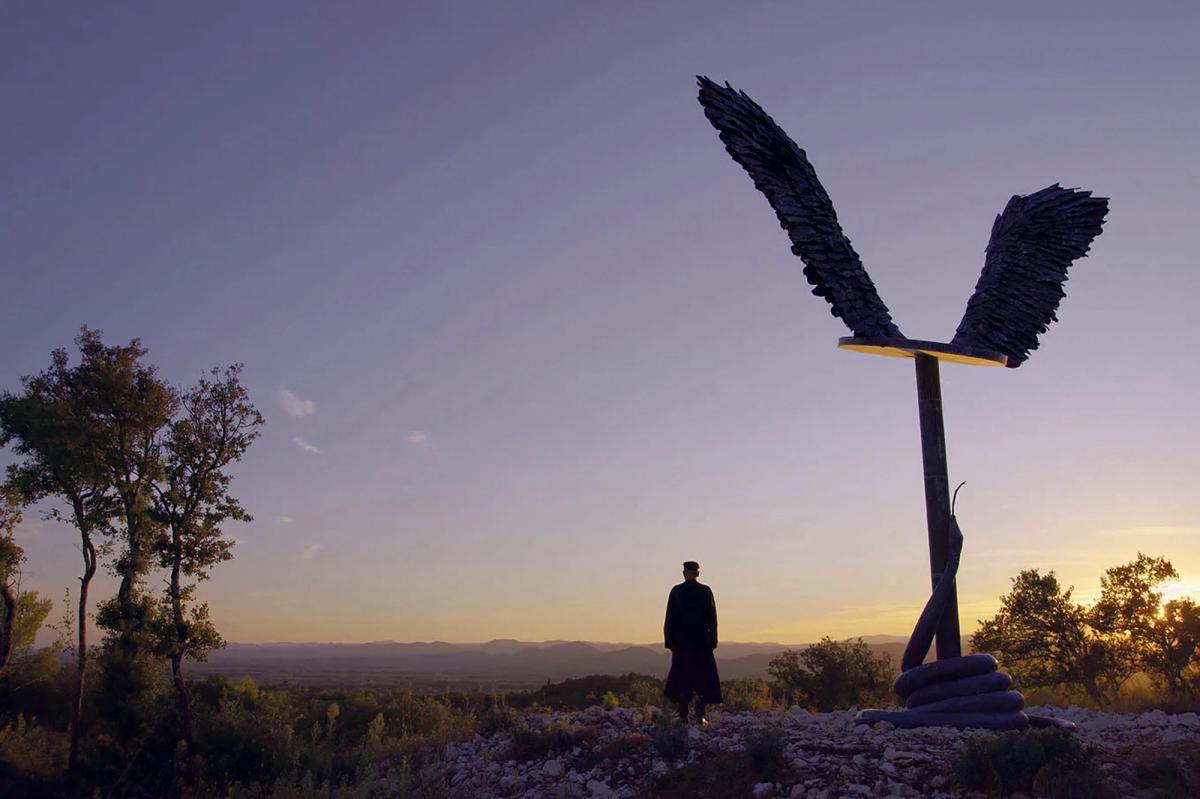The suspicion of gimmickry clings to 3D filmmaking. The serious 3D crazes, in the 1950s, 1980s and 2010s, emerged as theatrical moviegoing faced new competition from television, home video and cable and streaming; beyond the world of experimental cinema, the form has yielded more desperate novelty than futurist innovation. One exception from the post-Avatar 3D boom was Pina, Wim Wenders’s 2011 tribute to the choreographer Pina Bausch, in which the hyperreal depth of 3D compositions activated and defamiliarised the intimate physical geographies mapped by her work.
Wenders, a true believer who has continued to explore 3D in the intervening years, finds a new, almost equally satisfying use for it in Anselm, his new portrait of Anselm Kiefer. As the artist cycles through his hangar-like Paris atelier, past shelves of accumulated detritus rising to the ceiling, as he and his studio assistants apply blowtorches or pour molten lead onto his canvases, Wenders emphasises the density of Kiefer’s work, the accumulation of organic and inorganic material, which is also the accumulation of history at a frankly civilisational scale.
Wenders opens the film at the Eschaton Foundation, Kiefer’s new studio-estate in the south of France, his camera floating through a post-industrial landscape populated by ghostly junk sculptures and teetering concrete towers. More than just giving in to the irresistible Instagram-era appeal of sculpture gardens, Wenders evokes the Romantic habit of walks among the ruins, an attitude of morbid grandiosity that the film also gets at in other ways.
From the ashes
Interspersing archival footage of children playing on dusty heaps of concrete and scrap, Wenders draws an overarching parallel between Kiefer and the post-war Germany that rose, like him, from the ashes. Kiefer, an art star from early in his career, appears in footage from multiple previous documentary profiles, which does much of the expository lifting for Wenders, discussing his early provocative engagement with taboo nationalist imagery and his later references to ancient mythology. Such footage is often projected onto a sheet at the Eschaton—billowing and semi-transparent, a spectre of the archive.

Kiefer cycles through his cavernous Paris atelier Courtesy of Sideshow and Janus Films
Wenders mixes new footage of the master at work with imaginative sequences suggesting the inspiration for major Kiefer works, including readings from the poets Paul Celan and Ingeborg Bachmann, and re-enactments featuring Kiefer’s son Daniel and Wenders’s grand-nephew Anton as younger versions of the artist. Inquisitively traversing snowy landscapes, they gather images that the artist will recycle into his stark and monumental paintings. (3D is notorious for darkening the image; unless you are seeing Anselm in a theatre that has brightened its projector to compensate for the polarisation filter, push your glasses down your nose every so often to pick up the subtle throb of red and yellow within Kiefer’s compositions.)
Wenders’s production company is called Road Movies, and his name-making fiction films of the 1970s and 80s, shot all across Europe and the US, consolidated an improvisatory, open-ended approach Anselm echoes with its free-associative structure, a layering of memory to match the layering of paint and other media accumulated on Kiefer’s canvases. (Memories also layer across the Wenders oeuvre; a stray image of Kiefer walking a tightrope, persistent iconography of urban decay and a set of angel wings stashed in his studio all recall Wenders’s 1987 masterpiece Wings of Desire, a Kiefer-like meditation on the traces of experience accreted in modern-day West Germany.)
Yet the structure is hardly peripatetic. Of his preference for working in abandoned factories, Kiefer reflects that putting a rectangular frame around “chaos” turns it into art. He is unintentionally paraphrasing an observation made, more pejoratively, by the painter and film critic Manny Farber in his 1962 essay “White Elephant Art vs. Termite Art”, a screed against tiresome mastery in large-scale abstraction and cinema, and “the idea of art as an expensive hunk of well-regulated area, both logical and magical”. Farber’s complaints about how one specific film resolves its exploratory stabs into a static whole are particularly intriguing; The Loneliness of the Long Distance Runner, Farber wrote, “feels the fragments of a delinquent’s career have to be unified in a conventional story. The design...[—]a spokelike affair with each fragment shown as a memory experienced on practice runs—leads to repetitious scenes of a boy running.” Anselm is unified by repetitious scenes of Kiefer as a boy and young man walking, revisiting the scenes of his life and re-experiencing fragments of memory, in thrall to the oppressive weight of the past. Despite the scope of Kiefer’s catalogue and the poetic immersion of the 3D approach, all the wandering and pondering eventually becomes as monochrome as one of Kiefer’s lead book sculptures.
The film also carries an inborn irony: for all Kiefer’s fixation on ruins, on the dust-returned traces of modernity’s collapsed hubris haunting guilt-stricken landscapes, Anselm is a play for posterity, released just as the Eschaton Foundation has opened to the public, with guided tours through the rubble during the tourist season.
• Anselm opens at select theatres on 8 December


